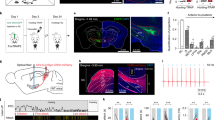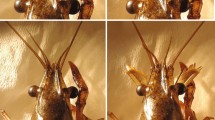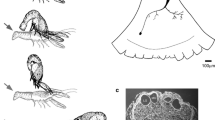Abstract
-
1.
Interactions of cockroaches with 4 different predator species were recorded by videography. Some predators, especially spiders, struck from relatively short distances and usually contacted a cockroach prior to initiation of escape (Table 1, Fig. 3). This touch frequently occurred on an antenna. Cockroaches turned away from the side on which an antenna was touched.
-
2.
We then measured the success of escape from predators for cockroaches with either cerci or antennae ablated. Only antennal removal caused a significant decrease in the success of escape from spiders (Fig. 5).
-
3.
With controlled stimuli, cockroaches responded reliably to abrupt touch of antennae, legs or body (Fig. 6). Responses resembled wind-elicited escape: they consisted of a short latency turn (away from the stimulus) followed by running (Figs. 7, 8). However, lesions show that touchevoked escape does not depend on the giant interneuron system (Table 2).
-
4.
Following section of one cervical connective, cockroaches continued to respond to touching either antenna, but often turned inappropriately toward, rather than away from, stimuli applied to the antenna contralateral to the severed connective (Table 3, Fig. 10).
-
5.
For certain types of predators touch may be a primary cue by which cockroaches detect predatory attack. Descending somatosensory pathways for escape are distinct from the GI system.
Similar content being viewed by others
Abbreviations
- CT:
-
contraversive turn
- GI:
-
giant interneuron
- IT:
-
ipsiversive turn
- VNC:
-
ventral nerve cord
References
Bell WJ (1990) Biology of the cockroach. In: Huber I, Masler EP, Rao BR (eds) Cockroaches as models for neurobiology: applications in biomedical research, vol I. CRC Press, Inc, Boca Raton, pp 7–12
Burdohan JA (1992) Descending mechanosensory interneurons as a substrate for evasive behavior in Periplaneta americana. PhD Dissertation, University of Illinois at Chicago
Burdohan JA, Comer CM (1989) Plurisegmental interneurons carrying antennal-derived tactile sensory information in the cockroach. Soc Neurosci Abstr 15:1287
Burdohan JA, Comer CM (1990) An antennal-derived mechanosensory pathway in the cockroach: descending interneurons as a substrate for evasive behavior. Brain Res 535:347–352
Camhi JM, Levy A (1988) Organization of a complex movement: fixed and variable components of the cockroach escape behavior. J Comp Physiol A 163:317–328
Camhi JM, Tom W (1978) The escape behavior of the cockroach Periplaneta americana. I. Turning response to wind puffs. J Comp Physiol 128:193–201
Camhi JM, Tom W, Volman S (1978) The escape behavior of the cockroach Periplaneta americana. II. Detection of natural predaors by air displacement. J Comp Physiol 128:203–212
Comer CM (1985) Analyzing cockroach escape behavior with lesions of individual giant interneurons. Brain Res 335:342–346
Comer CM, Dowd JP (1987) Escape turning behavior of the cockroach. Changes in directionality induced by unilateral lesions of the abdominal nervous system. J Comp Physiol A 160:571–583
Comer CM, Grobstein P (1981) Tactually elicited prey acquisition behavior in the frog, Rana pipiens, and a comparison with visually elicited behavior. J Comp Physiol 142:141–150
Comer CM, Dowd JP, Stubblefield GT (1988) Escape responses following elimination of the giant interneuron pathway in the cockroach, Periplaneta americana. Brain Res 445:370–375
Comer CM, Getman ME, Mungy MC, Plishka J (1989) Multisensory control of cockroach escape: Some predators are detected by antennal and other non-cereal sensory systems. Soc Neurosci Abstr 15:349
Copeland J, Carlson AD (1979) Prey capture in mantids: a nonstereotyped component of lunge. J Insect Physiol 25:263–269
Corrette BJ (1990) Prey capture in the praying mantis Tenodera aridifolia sinensis: coordination of the capture sequence and strike movements. J Exp Biol 148:147–180
Edwards JS, Reddy GR (1986) Mechanosensory appendages and giant interneurons in the firebrat (Thermobia domestica, Thysanura): A prototype system for terrestrial predator evasion. J Comp Neurol 243:535–546
Ewert J-P (1987) Neuroethology of releasing mechanisms: preycatching in toads. Behav Brain Sci 10:337–405
Farley R, Milburn N (1969) Structure and function of the giant fiber system of the cockroach, Periplaneta americana. J Insect Physiol 15:457–476
Guthrie DM, Tindall AR (1968) The biology of the cockroach. E Arnold (Publ) Ltd, London
Hess A (1958) Experimental anatomical studies of pathways in the severed central nerve cord of the cockroach. J Morphol 103:479–501
Husslein R, Gnatzy W (1989) Digger wasp against cricket: processing of tactile information by the prey. In: Neural mechanisms of behavior. Proc. 2nd Int Congr. Neuroethol, p 22
Johnson SE, Murphey RK (1985) The afferent projection of mesothoracic bristle hairs in the cricket, Acheta domesticus. J Comp Physiol A 156:369–379
Keegan AP, Comer CM (1993) The wind-elicited escape response of cockroaches is influenced by lesions rostral to the escape circuit. Brain Res 620:310–316
Keegan AP, Mara E, Comer CM (1991) Expanding the boundaries of the cockroach “escape circuit”: Lesions at the cervical level alter escape behavior evoked by touch and also responses elicited by wind. Soc Neurosci Abstr 17:1245
Melchers M (1967) Der Beutefang von Cupiennius salei Keyserling (Ctenidae). Z Morphol Ökol Tiere 58:321–346
Murphey RK (1985) A second cricket cereal sensory system: bristle hairs and the interneurons they activate. J Comp Physiol A 156:357–367
Nye SW, Ritzmann RE (1990) Videotape motion analysis of leg joint angles during escape turns of the cockroach. Soc Neurosci Abstr 16:759
Pollack AJ, Ritzmann RE (1992) Convergence of antennal and wind inputs on the escape system of the cockroach. Proc 3rd Int Congr. Neuroethol Abstr #251
Prete FR, Wolfe MM (1992) Religious supplicant, seductive cannibal, or reflex machine? In search of the praying mantis. J History Biol 25:91–136
Prete FR, Klimek CA, Grossman SP (1990) The predatory strike of the praying mantis, Tenodera aridifolia sinensis. J Insect Physiol 36:561–565
Ritzmann RE, Pollack AJ, Hudson SE, Hyvonen A (1991) Convergence of multi-modal sensory signals at thoracic interneurons of the escape system of the cockroach, Periplaneta americana. Brain Res 563:175–183
Roeder KD (1967) Nerve cells and insect behavior. Harvard Univ Press, Cambridge
Rovner JS (1980) Morphological and ethological adaptations for prey capture in wolf spiders (Aranaa, Lycosidae). J Arachnol 8:201–215
Roth LM, Willis ER (1960) The biotic associations of cockroaches. In: Smithson Misc Coll, vol 141. Smithson Inst, Washington
Sandeman DC, Varju D (1988) A behavioural study of tactile localization in the crayfish Cherax destrutor. J Comp Physiol A 163:525–536
Schal C, Gautier J-Y, Bell WJ (1984) Behavioural ecology of cockroaches. Biol Rev 59:209–254
Schaller D (1978) Antennal sensory system of Periplaneta americana. Cell Tissue Res 191:121–139
Schneiderman HA (1967) Insect surgery. In: Wilt F, Wessels N (eds) Methods in developmental biology. TY Crowell Co., New York, pp 753–766
Sekhar V, Reddy GR (1988) Mechanosensory regulation of predator evasion behaviour in the cockroach, Periplaneta americana. Current Sci 57:1141–1142
Sokal RR, Rohlf FJ (1981) Biometry, second edition. WH Freeman & Co, New York
Spira ME, Parnas I, Bergmann F (1969) Histological and electrophysiological studies on the giant axons of the cockroach Periplaneta americana. J Exp Biol 50:629–634
Stierle IE, Getman M, Comer CM (1994) Multisensory control of escape in the cockroach Periplaneta americana. I. Initial evidence from patterns of wind-evoked behavior. J Comp Physiol A 174:1–11
Weibrecht JM, Mizunami M, Strausfeld NJ (1991) The mushroom body of cockroach brain participates in spatial memory processing. Soc Neurosci Abstr 17:1228
Wourms MK (1981) House mouse predation on cockroaches. J Mammol 62:853–854
Author information
Authors and Affiliations
Rights and permissions
About this article
Cite this article
Comer, C.M., Mara, E., Murphy, K.A. et al. Multisensory control of escape in the cockroach Penplaneta americana . J Comp Physiol A 174, 13–26 (1994). https://doi.org/10.1007/BF00192002
Accepted:
Issue Date:
DOI: https://doi.org/10.1007/BF00192002




